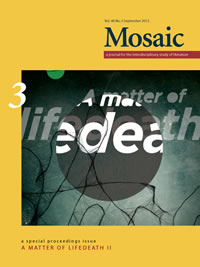Issue 48.3
Overview

Special Issue: A matter of lifedeath II
Published: September 2015
View the issue introduction or see the issue summary and contents below.
13 essays, totalling 224 pages
$24.95 CAD
This special Mosaic issue, the second of three conference proceedings issues, collects papers presented at the A matter of life death conference held at the University of Manitoba from October 1-4, 2014. Most of the papers have been revised, some lengthened, into publishable essay form and, as always, we are grateful to contributors for their cooperation and more than a little proud to print their fine work.
Mourning as the Origin of HumanityFrancoise Dastur In this essay, I suggest that the most original manner of defining humans might be simply to say that they are strange animals who bury their dead, since that which characterizes humanity as such is the refusal to submit to the natural order, this cycle of life and death that rules over all living beings. This explains the importance in all cultures of the practice of funeral rites. The death with which we are confronted is the death of others, and in particular of those who are close to us. Mourning can therefore be defined as the human capacity of having a relation to those who are no longer present in the world. Seen in this light, mourning can be considered as the fundamental mode of being human. | |
Dying AliveKas Saghafi It is in his seminar The Beast & the Sovereign, Volume II that Derrida comes to argue that the phantasm, “dying alive,” and survival need to be thought in relation to, and with, each other. This essay explores the intriguing confluence of these three terms. | |
Democracy, Climate Change, and Environmental JusticeMatthias Fritsch Taking its cue from Derrida’s rethinking of political life as lifedeath, this essay argues that taking turns helps in conceptualizing the intra- and inter-generationally shared nature of democratic institutions. However, the generational taking turns with democratic power must be thought in conjunction with an environmental turning: not only do human generations seek to share sovereignty over subjects and the earth, but such human sovereignty is dependent upon a lateral turning with the earth. | |
Love, Life, Death, and SurvivalDiane Enns This essay explores the confluence of two poignant works by philosophers facing death in order to reflect on the death of love. In their protest against limits, Jacques Derrida and Gillian Rose affirm the intensity and agonism of survival over perfectibility, of revel over consolation—in life as in love. | |
Adapting Venice: Intermedial Relations in Visconti, Sebald, and KafkaRussell J.A. Kilbourn This essay compares Luchino Visconti’s Death in Venice and Vertigo, W.G. Sebald’s first prose narrative, which adapts various texts by Franz Kafka, in order to explore how in each work the protagonist must re-negotiate his identity in a confrontation with his death, whether literally or metaphorically. Venice is never simply setting or backdrop to the action, emerging as emblematic of a cultural moment in which representation and reality have become inextricably entangled, and in which the human subject is unavoidably transformed. | |
Phantasmatics: Sovereignty and the Image of Death in Derrida’s First Death Penalty SeminarGwynne Fulton By way of a double reading of the temporality of guillotine and photography in the anonymous 1939 film of the execution of Eugène Weidmann, this essay examines the putative instantaneity of death, which posits life as that which happens only before death. | |
Our Sovereign Others: Phantasms, Heidegger, AnimalityRyan C.P. Fics This essay considers the relationship that Derrida explores in The Beast & the Sovereign, Volume II between Robinson Crusoe’s fantasy of a “living death” and Martin Heidegger’s structure of the “as such.” I make the case that what Derrida refers to as the auto-hetero-affective dimension of the phantasm involves a very dangerous yet fruitful mode of critique. | |
Individuated Embodiment and Action: Interrogating Roberto Esposito’s Negative SelfAntonio Calcagno This essay argues that the resistance of the negative self to politicization that Roberto Esposito posits requires a more robust account for the facticity of individual embodiment and agency, which ultimately challenge the originary space that characterize Esposito’s claims about possible sites of resistance. | |
Lost in Liminal Space: Amnesiac and Incognizant Ghosts in Korean DramaSung-Ae Lee Some recent Korean TV drama series have developed narratives that centre on amnesiac or incognizant ghosts. Because of their crucial acts of forgetting and miscomprehension, these ghosts may be used to figure the social injustices and repressed traumas that haunt contemporary South Korean society. | |
Sensing Sentience and Managing Microbes: Lifedeath in the SlaughterhouseKara Wentworth This essay explores the details of how life and death are separated and managed on a small slaughterhouse kill floor, arguing that these practices cast animals, consumers, microbes, and kill floor workers as killable, protectable, or manageable. | |
Of Wonder and Encounter: Textures of Human and Nonhuman RelationalityDominique Hétu The novels Sous Béton by Karoline Georges and Room by Emma Donoghue dramatize moments of wonder in meaningful encounters between children and nonhuman figures. This essay argues that this sense of wonder renders possible an “endless process of becoming” in life-threatening situations of emotional and corporeal vulnerability (McCann 499). | |
The Animal Mirrors: The Human/Animal Divide in Derrida and DeleuzeJames Martell Starting with an analysis of Jacques Derrida’s most intimate encounter with an animal by way of a similar scene in Balthus’s paintings, this essay examines Derrida’s criticism of Gilles Deleuze’s understanding of the human-animal relation and proposes a way of conceiving the animal-human encounter beyond the traps of narcissism. | |
Necro-Eco: The Ecology of Death in Jim Crace’s Being DeadSarah Bezan This essay reads the decomposition of the human corpse in Jim Crace’s novel Being Dead as an expression of active, vital, agential, and transformative inter-species interaction. Affirming the creative possibilities of putrefaction, my analysis of Crace’s necro-ecological narrative emphasizes the vitality of death through the entangled interactions of organisms both human and non-human, living and dead. |